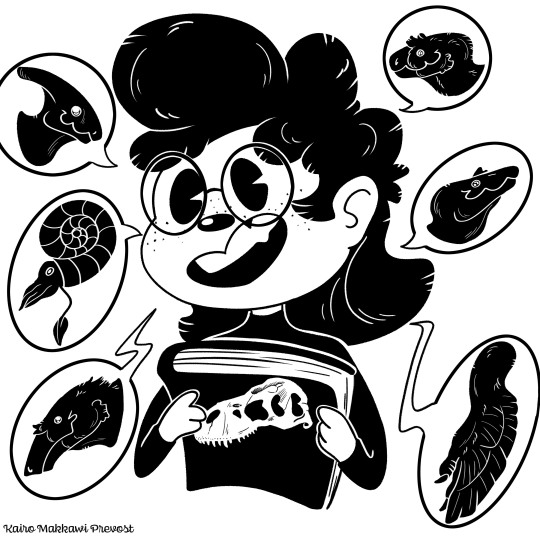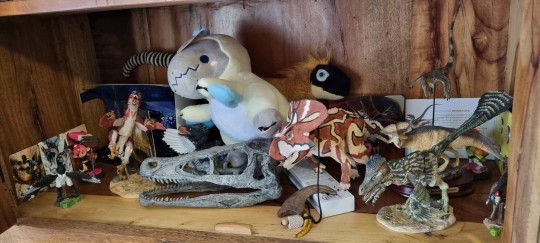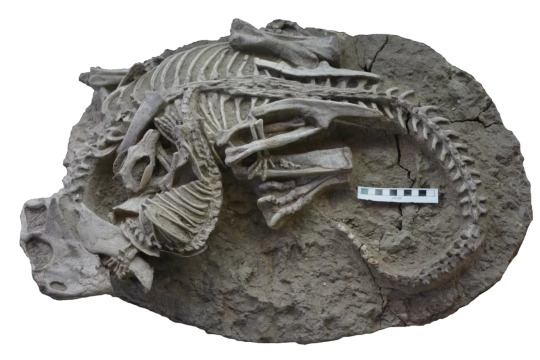#mesozoic fossils
Explore tagged Tumblr posts
Text







friends :)
#paleontology#mesozoic#late cretaceous#pleistocene#gryposaurus#akainacephalus#ankylosaurus#hagryphus giganteus#hagryphus#deinosuchus#bison#ice age bison#giant bison#mammoth#mamuthus#columbian mammoth#fossils#dinosaurs#dinosaur#dinosaur fossils#natural history#earth history#earth science#natural science#mesozoic fossils#cretaceous period#cretaceous fossils#cenozoic
30 notes
·
View notes
Text

This Fossil Friday, meet the Museum’s mummified hadrosaur—one of the most complete pieces of Mesozoic dinosaur remains ever found! This fossil represents one of the greatest discoveries in the history of paleontology: a rare glimpse at the texture of dinosaur skin. Like the skin on modern birds’ feet, this duck-billed dinosaur’s skin was marked by bumps called tubercles. The tubercles are larger along the animal’s back and sides and smaller around the joints, which needed to be flexible.
Photo: Image no. ptc-7737 �� / AMNH Library (Circa 1992)
#science#amnh#museum#fossil#natural history#animals#dinosaur#fact of the day#paleontology#cool animals#duck billed dinosaur#nature#spooky season#mummies#mesozoic
2K notes
·
View notes
Text

The Triassic Cuddle
#art#my art#my art i guess#digital art#my artwork#illustration#digital painting#digital illustration#medibang#medibang art#the triassic cuddle#paleoart#prehistoric art#thrinaxodon#broomistega#triassic#paleontology#fossils#prehistoric animals#mesozoic#triassic cuddle#fossil art#wildlife art#wildlife#wildlife illustration#animal illustration
602 notes
·
View notes
Text

#biology#palaeoart#fossils#geology#paleoart#sciart#science#mesozoic#palaeontology#dinosaurs#sauropelta#nodosaur#ankylosaur#dinosaur art#dinosaur
148 notes
·
View notes
Text

[ The skull is mounted on a custom steel armature, which allows for it to be seen all the way around. ]
"After seven years of work, the best preserved and most complete triceratops skull coming from Canada — also known as the "Calli" specimen — is on display for the first time since being found in 2014 at the Royal Tyrrell Museum in Drumheller, Alta. A museum news release calls the specimen "unique" because of where it was discovered, the age of the rock around it, and how well it was preserved. Following the floods that tore through Alberta about 10 years ago, the Royal Tyrrell staff were engaged in flood mitigation paleontology work when the triceratops skull was discovered in 2014. Triceratops fossils are rare in Canada. This skull was found in the foothills of southwestern Alberta — an area where dinosaur fossils in general are uncommon — and nicknamed "Calli" after Callum Creek, the stream where it was discovered. Transported via helicopter in giant, heavy chunks, the skull and most of the jaw pieces were extracted over the course of a month in 2015. The rest of the triceratops' skeleton was not found. Roaming the earth roughly 68 to 69 million years ago, the museum says this skull was buried in stages, evident by the fossilization process. "Paleontologists know this because the specimen was found in different rock layers, and the poorly preserved horn tips suggest they were exposed to additional weathering and erosion," reads a museum blog about the triceratops skull. "The rest of the skeleton likely washed away," noting that the lower jaws were found downstream. From 2016 to 2023, Royal Tyrrell technician Ian Macdonald spent over 6,500 hours preparing this fossil, removing over 815 kilograms of rock that encased the skull. This triceratops skull is the largest skull ever prepared at the museum and its third largest on display."
Read more: "Canada's biggest and best triceratops skull on display in Alberta" by Lily Dupuis.
#palaeoblr#Palaeontology#Paleontology#Dinosaur#Triceratops#Fossil#Cretaceous#Mesozoic#Ceratopsian#Extinct#Prehistoric#Photo#Article#Information#Museum#Royal Tyrrell Museum
2K notes
·
View notes
Text

A partial Cretaceous coelacanth jaw of an Axelrodichthys lavocati from the Kem Kem Group in Hassi Zguilma, Morocco. This species of mawsoniid coelacanthiform was formally, and may still be, assigned to the genus Mawsonia. These giant lobe-finned fish were likely a vital food source for the larger piscivorous predators in the deposit such as Spinosaurus, Sigilmassasaurus, and Elosuchus.
#fish#coelacanth#fossils#paleontology#palaeontology#paleo#palaeo#axelrodichthys#mawsonia#mawsoniidae#cretaceous#mesozoic#prehistoric#science#paleoblr#fossil friday#fossilfriday#アクセルロディクティス#マウソニア#シーラカンス#化石#古生物学#マウソニア科
123 notes
·
View notes
Text




Series of drawings for a personal project. Featuring the Cretaceous dinosaur Acrocanthosaurus atokensis, one of the largest and most successful theropods found in North America.
#artists on tumblr#paleoblr#paleoart#paleomedia#dinosaur#prehistoric#cretaceous#mesozoic#jurassic park#prehistoric planet#acrocanthosaurus#acro#fossil friday#carcharodontosaur#theropod#fran
63 notes
·
View notes
Text
i got a fossil >:3

mosasaur tooth >:3
31 notes
·
View notes
Text
Wordplay Wednesday: Dorsal and Ventral
Like anterior and posterior, dorsal and ventral are terms for front and back but not in the same way. In most organisms it refers literally to the back (dorsal vertebrae for example means back vertebrae) or top of the body. On the other hand, ventral refers to the belly or bottom of the body. Using our sauropod, you can see how these two terms work alongside last weeks words:

Of course, this also works on a smaller scale as well such as a single element (bone).

Now you can add a few more words to your science vocab. Tune in tomorrow for an insane story about Brontosaurus!
38 notes
·
View notes
Note
John Hammond from Jurassic Park?









John Hammond (Jurassic Park)
#livi’s moodboards#aesthetic#moodboards#moodboard#live action movies#science#dinosaurs#skeletons#fossils#jurrasic park#John Hammond#white#silver#gray#camera#monochrome#dinosaur#paleontology#biology#mesozoic#Dino
14 notes
·
View notes
Text

teacher asked us to draw ourselves an avatar :3
#meet the artist#art#digital art#sombertide art#paleoart#paleontology#dinosaur#natural history#paleo#dino#mesozoic#skull#fossil#ammonite#theropod#hadrosaur#rubberhose#cartoon art#toons#cartoonist#cartoon#cartoon characters
72 notes
·
View notes
Text






Museum of Natural History of Utah!
#paleontology#mesozoic#late jurassic#late cretaceous#dinosaurs#fossils#museum of natural history#allosaurus#gryposaurus#triceratops#duckbilled dinosaur#natural history#earth history#earth science#dinosaur fossils#jurassic period#cretaceous period#nature#earth
25 notes
·
View notes
Text
Meet “the sheep of the Mesozoic,” Protoceratops andrewsi. This herbivore was a very common animal and is remarkably well-represented in the fossil record.
#science#amnh#museum#nature#natural history#fossil#animals#fact of the day#did you know#dinosaur#protoceratops#mesozoic#cool animals#paleontology
666 notes
·
View notes
Text
My Raptor Collection.

#afternoon fika#paleomerch#velociraptor#saurornitholestes#zhenyuanlong#claw#utahraptor#mononykus#protoceratops#beast of the mesozoic#plush#wild republic#afternoonfika#vivi the velociraptor#microraptor#dromeosaur#raptor claw#sickle claw#theropod#dinosaur#skull#parave#paleoblr#palaeontology#paleontology#paleo#dino#dinosaurs#fossil replica
28 notes
·
View notes
Text

The smell of rain fills the air, though not a single drop has fallen. A huge Mosasaurus slowly swims through a warm, shallow sea, unbothered by the noisy pterosaurs.
The world seems half asleep.
Everything is gray.
#biology#palaeoart#fossils#geology#mesozoic#paleoart#sciart#science#palaeontology#dinosaurs#mosasaurus#pterosaur#nyctosaurus#pteranodon#coral reef#reef#cretaceous period#late cretaceous#prehistoric#prehistoric planet#nasilow#nasiłów
164 notes
·
View notes
Text

[ The fossilised remains of a Psittacosaurus, an Early Cretaceous ceratopsian, and Repenomamus, one of the largest mammals during the Mesozoic. ]
"When dinosaurs ruled the Earth, we tend to think of the mammals at the time — including our distant ancestors — as small and quivering in the shadows. "We've always had this picture of mammals as the literal underdogs," says Elsa Panciroli, a paleontologist at the Oxford University Museum of Natural History. "They're being trampled. They're cowering in the darkness at night, just trying to avoid being eaten." But a remarkable new fossil, originating in the early Cretaceous some 125 million years ago and now described in the journal Scientific Reports, conjures a rather different possibility. It consists of two intertwined skeletons — an upstart mammal sinking its teeth into a much larger dinosaur. "Our best guess is that the mammal was in the middle of attacking the dinosaur," says Jordan Mallon, one of the authors of the new study and a paleobiologist at the Canadian Museum of Nature. If true, such a revelation shakes our traditional view of dinosaur domination and mammal submission. It suggests a more complex ancient food web in which certain dinosaurs were prey and some mammals were predators. In the case of this particular fossil that was unearthed in modern-day northeast China, "this mammal appears to have been particularly gutsy or voracious," Mallon says."
Read more: "This fossil of a mammal biting a dinosaur captures a death battle's final moments" by Ari Daniel.
#palaeoblr#Palaeontology#Paleontology#Fossil#Cretaceous#Psittacosaurus#Dinosaur#Ceratopsian#Repenomamus#Mammal#Mesozoic#Extinct#Prehistoric#Article
613 notes
·
View notes